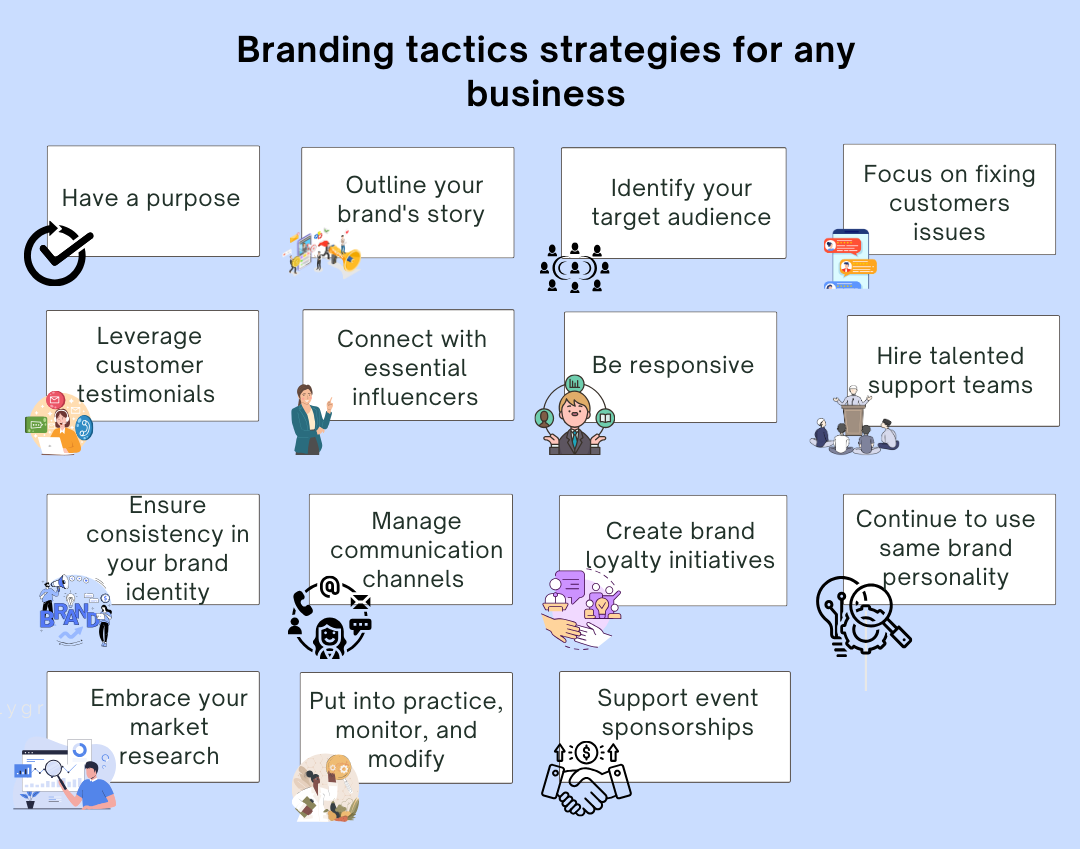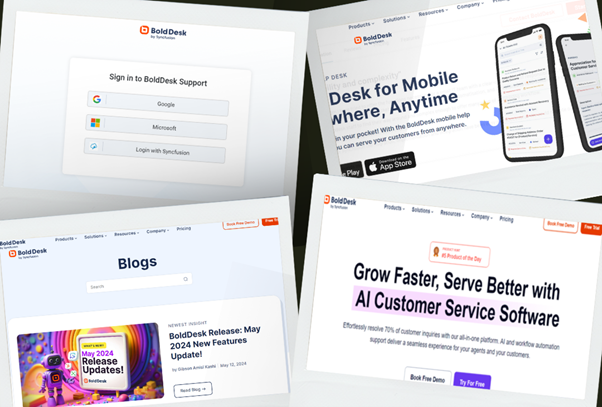Every brand strives to stand out and grab customers’ attention in today’s saturated marketplace. Branding tactics are key for capturing your audience’s attention and making them remember you.
Whether you are a new business, a large company, or a marketing expert, you need valuable branding wisdom to help you reach and attract wider audiences.
This blog will discuss branding tactics and why they’re important.
What are branding tactics?
Branding tactics are long-term strategies and techniques that a business uses to create a strong and favorable brand identity and reputation.
The branding techniques employed need to reflect the company’s goals. They should emphasize your business’s distinctive qualities, how it sets itself apart from rivals, its unique selling proposition, and the value you offer clients.
Everything from a company’s logos and color schemes to its tone and writing style are all part of a brand image.
However, having these elements for your business is just one part of branding.
The other part is promoting these elements and creating a picture of your brand in the consumers’ minds.
This involves cultivating a specific perception of your brand through deliberate choices during customer interactions.
By consistently strengthening your brand, you can build trust, loyalty, and brand recognition in your target market.
How to create and implement brand tactics
This section discusses how to write the best branding tactics that business can use to build their brand and strengthen people’s perception of it.

Have a purpose
First, ensure your branding tactics align with a clear goal to attract potential customers.
An effective goal goes beyond just selling a product or service, giving your company a cause to rally behind, and attracting customers who share your values.
This emotional connection builds loyalty and turns customers into repeat buyers.
Outline your brand’s story
Your brand story is the foundation of all marketing and branding strategies. Every company has an origin story.

Develop a narrative about your company’s start, values, and growth over the years that resonates with your audience emotionally.
Ask yourself questions like “What is my brand?” and “Why is my brand here?” to help you develop a narrative that highlights your distinctiveness.
Identify your target audience
Find out who your target audiences are and design your branding to suit their general tastes.
Understand them to create emotion-touching messages and set the right tone with your branding.
This will help you develop a strong and relevant brand image that appeals to your target audience.
Focus on fixing customers’ issues
Your branding should be about helping solve client issues. Highlight the advantages you offer and how your product or service makes their lives better in your company motto and story.
In every day interactions, your employees can enforce this by concentrating on solving client issues, earning recognition and goodwill for an outstanding customer service experience.
Leverage customer testimonials
Testimonials are a powerful tool for building confidence in your brand. Clients are more likely to purchase from recommended places with great reviews.

Display positive customer testimonials on your website, link to third-party review sites, and strategize to elicit more quotable feedback from satisfied customers.
Their words can do more to inspire trust and credibility than anything published by employees. They heavily influence customer perception of your brand.
Connect with essential influencers
Partner with people who share your target market’s interests to enhance brand awareness and reach. Carefully choose partners whose values match your brand’s and whose style meshes well.
Be responsive
If you want to cultivate a brand reputation for being customer-centric, respond to clients’ comments, messages, and reviews.
You want to demonstrate that you care about their feedback and value their input.
According to Linearity, a brand’s messages and communication style contribute to about 45% of its overall image.
Understanding your audience helps you make sure to customize your messaging to reflect your brand’s tone.
Hire talented support teams
Recruit skilled individuals to represent your company and aid in brand development.
Hiring employees with experience can be expensive for startups, but people with talent come at all levels of experience, so the key is to hire carefully for potential.
These are the people who interact with customers at their most frustrated. Such customers are some of the most likely to post reviews. So your brand’s reputation will be heavily influenced by their experiences with your team.
Ensure consistency in your brand identity
Use consistent logos, colors, fonts, messaging, and voice across all marketing materials.

When you design memorable branding elements, it will be the first thing your audiences notice about your brand.
Create guidelines for consistent branding across marketing channels. Ensure it is eye-catching, unique, and reflective of your brand personality.
Manage communication channels
Establish a solid presence on public communication channels such as community forums, live chat, social media platforms, and mobile applications. These communication platform are where customers can connect and interact with each other and your brand.
Share interesting content that encourages discussions and nurtures connections with your followers.
According to Zonka reports, 33% of customers would recommend a brand that responds quickly but ineffectively.
Reply quickly to comments and inquiries to show you value customer engagement and strengthen customer relationships.
Create brand loyalty initiatives
To build a strong connection with customers, consider offering discounts and exclusive deals to those on your mailing list. Also consider implementing a loyalty program for repeat buyers.
For some brands, being perceived as exclusive is a goal. For others, the occasional benefits will establish a sense in customers that your brand provides good deals and value.
Continue to use the same brand personality
Ensure that your brand voice is the same on all channels, including your visual elements. Choose a tone that aligns with your business.
Carefully craft a personality for your brand and make sure everyone is on board with how to express it.
Consistency in your visual and communication styles across all platforms strengthens brand recognition.
Additionally, adopting an omnichannel approach ensures that your brand delivers a seamless and unified experience across all customer touchpoints. This further reinforces your brand identity, fostering customer loyalty.
Embrace your market research
Frequently research and understand your target audience to tailor your branding strategies effectively.
Keeping informed on the current trends and experiment to determine the most efficient methods for engaging your target audience.
Monitoring your competitors’ actions can also give you an idea of what works with particular demographics and what doesn’t.
Put into practice, monitor, and modify
Track and test your branding tactics periodically to ensure you create the brand perception you intended.
Make required adjustments to align your branding tactics with your business’s long-term and short-term goals.
Support event sponsorships
Consider sponsoring events closely related to your brand to enhance your visibility and credibility.
Associating your brand with positive events not only presents your business in a favorable light but also makes it possible for you to communicate with more people.
As a result, your brand recognition will increase over time.
Benefits of branding tactics
Branding tactics should be included in your overall marketing strategy for multiple reasons:
- Increases brand awareness: Branding creates a unique and identifiable image for your business, allowing it to stand out in consumers’ memories. By consistently using the same logo design, colors, and design elements, businesses can ensure they are quickly recognized and distinguished from others in the market.
- Boosts customer loyalty: Effective branding tactics build an emotional bond with customers, cultivating customer loyalty. A well-established brand becomes a part of the personal identity of many consumers.
- Enhances credibility: Wide-spread brand recognition leads to companies being perceived as trustworthy and dependable, encouraging new customers to take a risk on your product. Consistent and professional branding enhances credibility in the eyes of customers and stakeholders.
- Ease of introducing new products: A strong brand reputation can make introducing and selling new products easier, as customers trust and believe in the brand. This can lead to higher sales and reduce the challenge of selling new products.
- Differentiates you from competitors: Your branding incorporates your unique value proposition (UVP). Your UVP should be the main message you use in all your branding efforts, making your brand stand out and connect with your target audience.
- Increases sales and revenue: Creating a strong brand and backing it up with good products and performance turns customers into loyal supporters of your brand. This not only drives repeat business and the ability to charge higher prices, but it also serves as free marketing through word-of-mouth recommendations.
Grow your customer base with branding tactics
Without a structured approach to branding tactics, companies may struggle to define themselves in the market.
Determine your company’s goals, the best way to engage with your customers, and how to invest in branding strategies more effectively than your competitors.
Contact us to arrange a live demo and experience how BoldDesk can incorporate and promote your brand identity, creating consistent messaging and a reputation for excellent support. Sign up for a free trial for hands-on access to all BoldDesk’s features.
I hope you found this article useful. Do you have any more ideas or recommendations for brand tactics? Leave your comments in the section below.
Related articles


















 Email Ticketing System
Email Ticketing System Shared Inbox Software
Shared Inbox Software Multi Brand Help Desk
Multi Brand Help Desk Internal Help Desk Software
Internal Help Desk Software Trouble Ticketing Software
Trouble Ticketing Software Mobile Help Desk
Mobile Help Desk 


















